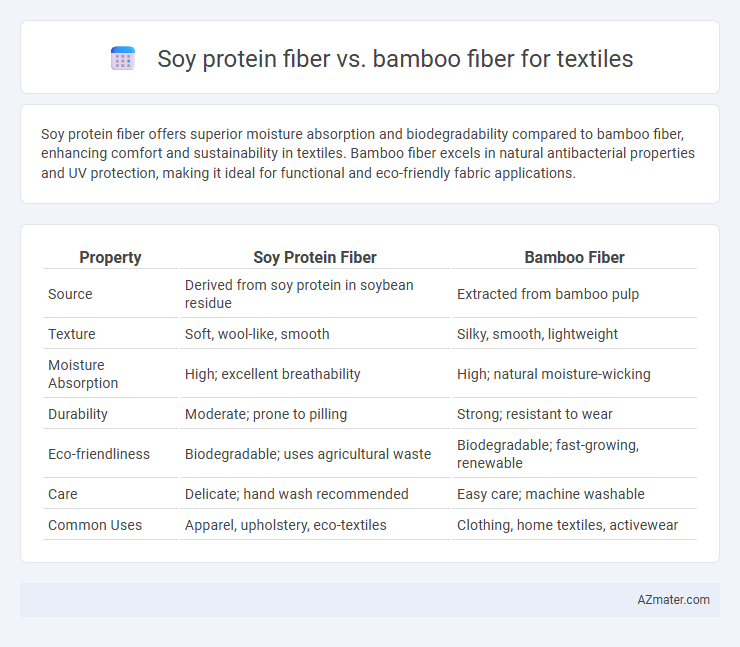Soy protein fiber offers superior moisture absorption and biodegradability compared to bamboo fiber, enhancing comfort and sustainability in textiles. Bamboo fiber excels in natural antibacterial properties and UV protection, making it ideal for functional and eco-friendly fabric applications.
Table of Comparison
| Property | Soy Protein Fiber | Bamboo Fiber |
|---|---|---|
| Source | Derived from soy protein in soybean residue | Extracted from bamboo pulp |
| Texture | Soft, wool-like, smooth | Silky, smooth, lightweight |
| Moisture Absorption | High; excellent breathability | High; natural moisture-wicking |
| Durability | Moderate; prone to pilling | Strong; resistant to wear |
| Eco-friendliness | Biodegradable; uses agricultural waste | Biodegradable; fast-growing, renewable |
| Care | Delicate; hand wash recommended | Easy care; machine washable |
| Common Uses | Apparel, upholstery, eco-textiles | Clothing, home textiles, activewear |
Introduction to Soy Protein Fiber and Bamboo Fiber
Soy protein fiber, derived from soybean processing byproducts, offers excellent moisture absorption and biodegradability, making it a sustainable choice for eco-friendly textiles. Bamboo fiber, extracted from bamboo pulp, is renowned for its natural antibacterial properties, softness, and durability, suited for comfortable and hygienic clothing. Both fibers provide renewable alternatives to synthetic textiles, with soy protein fiber emphasizing nutrition-derived materials and bamboo fiber highlighting rapid growth and antimicrobial benefits.
Origins and Production Processes
Soy protein fiber originates from the byproducts of soybean processing, where the protein is extracted and spun into fibers through a wet spinning technique that preserves its natural amino acids. Bamboo fiber is derived from the cellulose of bamboo plants, undergoing mechanical crushing or chemical treatments to break down the woody material into usable textile fibers. Both fibers involve eco-friendly raw materials, but soy protein fiber emphasizes fermentation and protein regeneration, while bamboo fiber relies heavily on cellulose extraction and purification methods.
Environmental Impact Comparison
Soy protein fiber generates significantly lower carbon emissions and consumes less water than bamboo fiber, making it a more sustainable choice in textile production. Bamboo fiber, while renewable due to rapid plant growth, often requires extensive chemical processing that can release harmful pollutants into the environment. Both fibers offer biodegradable options, but soy protein fiber's cultivation and processing impact tend to be more eco-friendly overall.
Physical Properties and Texture
Soy protein fiber exhibits excellent softness and a smooth texture, closely resembling natural silk, with high moisture absorption and moderate durability ideal for comfortable textiles. Bamboo fiber offers superior breathability, antimicrobial properties, and a slightly coarser texture, combined with high tensile strength and good elasticity, making it suitable for activewear and durable fabrics. Both fibers provide eco-friendly alternatives, but soy protein fiber is preferred for softness and skin-friendliness, while bamboo fiber excels in moisture management and strength.
Moisture Absorption and Breathability
Soy protein fiber exhibits excellent moisture absorption due to its protein structure, which allows efficient wicking of sweat from the skin, enhancing comfort in textiles. Bamboo fiber possesses superior breathability thanks to its micro-gaps and micro-holes, promoting air circulation and quick drying properties in fabric. Combining these fibers in textile applications can optimize moisture management and breathability for improved wearer comfort.
Dyeability and Color Retention
Soy protein fiber exhibits excellent dyeability due to its protein-based structure, allowing it to absorb a wide range of dyes deeply for vibrant colors. Bamboo fiber, primarily cellulose-based, has moderate dye uptake but often requires chemical treatment to improve color retention. Soy protein fibers maintain color intensity longer after multiple washes compared to bamboo fibers, which can fade more rapidly due to their hydrophilic nature.
Durability and Wear Resistance
Soy protein fiber offers moderate durability and wear resistance due to its natural protein structure, making it suitable for lightweight, comfortable textiles but less ideal for heavy-duty use. Bamboo fiber, known for its natural cellulose composition and antimicrobial properties, exhibits higher wear resistance and durability, especially when processed using mechanical or enzymatic methods that enhance fiber strength. Textiles made from bamboo fiber tend to withstand repeated washing and abrasion better than soy protein fibers, making bamboo a preferred choice for long-lasting, resilient fabrics.
Comfort and Skin Sensitivity
Soy protein fiber offers excellent softness and breathability, making it ideal for sensitive skin and enhancing overall comfort in textiles. Bamboo fiber naturally possesses antibacterial and moisture-wicking properties, reducing irritation and keeping skin dry and comfortable throughout wear. Both fibers provide hypoallergenic qualities, but soy protein fiber tends to be preferred for its silk-like texture, while bamboo fiber excels in durability and odor resistance.
Cost and Market Availability
Soy protein fiber generally offers a moderate cost structure due to its production from soybeans, balancing sustainability and affordability, while bamboo fiber often incurs higher expenses linked to extensive processing methods. Market availability for soy protein fiber is steadily expanding, supported by agricultural byproducts and growing eco-friendly demand, whereas bamboo fiber benefits from widespread cultivation but faces supply fluctuations and higher competition in textile markets. Both fibers serve niche sustainable textile sectors, with soy protein fiber gaining traction in cost-sensitive applications and bamboo fiber favored for premium softness and durability.
Applications in Textile Industry
Soy protein fiber exhibits excellent moisture absorption, softness, and biodegradability, making it ideal for eco-friendly activewear, underwear, and baby clothing within the textile industry. Bamboo fiber offers natural antibacterial properties, high breathability, and UV protection, which suits applications in sportswear, outdoor fabrics, and bedding textiles. Both fibers provide sustainable alternatives to synthetic materials, with soy protein favored for comfort and bamboo for antimicrobial performance.

Infographic: Soy protein fiber vs Bamboo fiber for Textile
 azmater.com
azmater.com